2018 MERCEDES-BENZ S-CLASS SEDAN lock
[x] Cancel search: lockPage 15 of 562
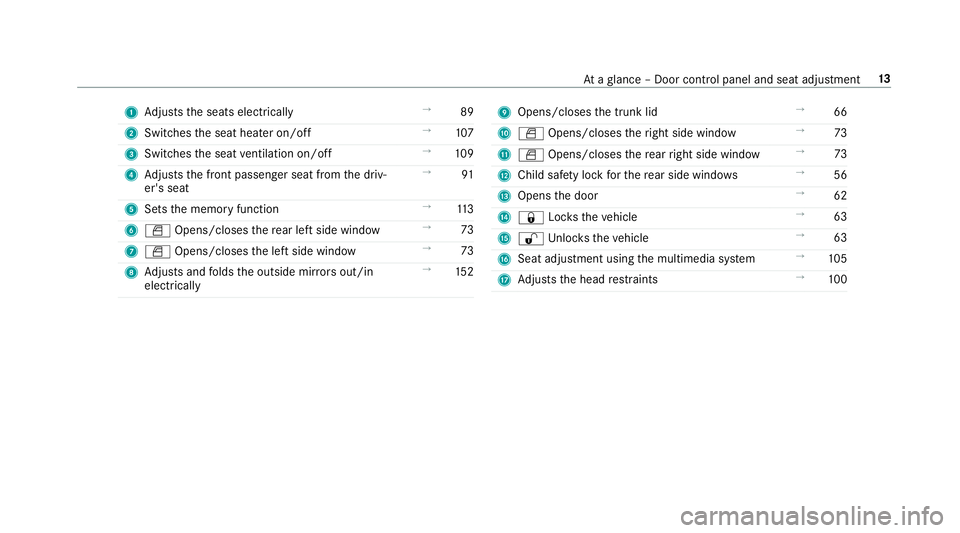
1Adjusts the seats electrically →
89
2 Switches the seat heater on/off →
107
3 Switches the seat ventilation on/off →
109
4 Adjusts the front passenger seat from the driv‐
er's seat →
91
5 Sets the memory function →
113
6 W Opens/closes there ar left side wind ow→
73
7 W Opens/closes the left side window →
73
8 Adjusts and folds the outside mir rors out/in
electrically →
1529
Opens/closes the trunk lid →
66
A W Opens/closes theright side window →
73
B W Opens/closes there ar right side window →
73
C Child saf etyloc kfo rth ere ar side wind ows →
56
D Opens the door →
62
E & Lockstheve hicle →
63
F % Unlockstheve hicle →
63
G Seat adjustment using the multimedia sy stem →
105
H Adjusts the head restra ints →
100
At aglance – Door control panel and seat adjustment 13
Page 26 of 562
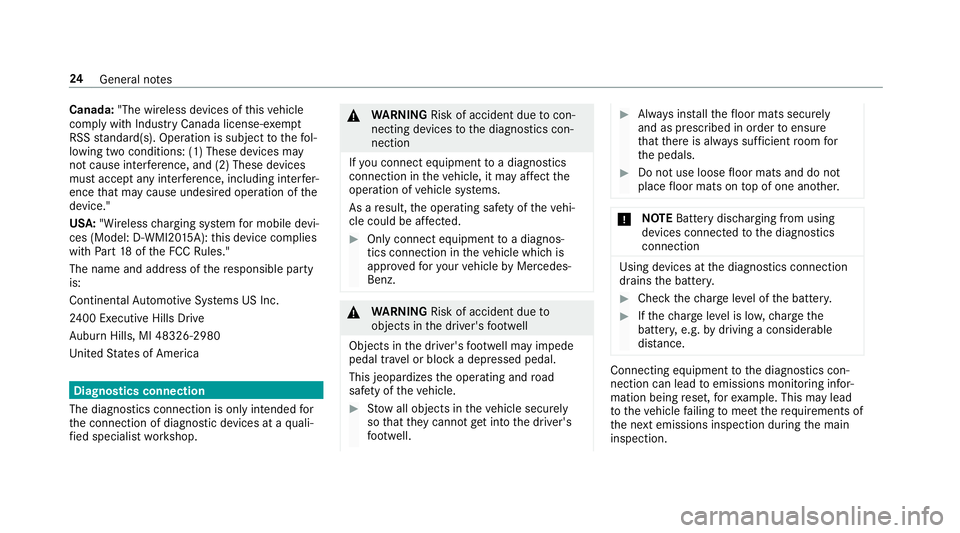
Canada:"The wireless devices of this vehicle
comply with Industry Canada license-e xemp t
RSS standard(s). Operation is subject tothefo l‐
lowing two conditions: (1) These devices may
not cause inter fere nce, and (2) These devices
must accept any inter fere nce, including inter fer‐
ence that may cause undesired operation of the
device."
USA: "Wireless charging sy stem for mobile devi‐
ces (Model: D-WMI20 15A): this device complies
with Part18 ofthe FCC Rules."
The name and address of there sponsible party
is:
Continental Automotive Sy stems US Inc.
24 00 Executive Hills Drive
Au burn Hills, MI 48326-2980
Uni tedSt ates of America
Diagnostics connection
The diagnostics connection is only in tended for
th e connection of diagnostic devices at a quali‐
fi ed specialist workshop.
&
WARNING Risk of accident due tocon‐
necting devices tothe diagnostics con‐
nection
If yo u connect equipment toa diagnostics
connection in theve hicle, it may af fect the
operation of vehicle sy stems.
As a result, the operating saf etyof theve hi‐
cle could be af fected.
#Only connect equipment toa diagnos‐
tics connection in theve hicle which is
appr ovedfo ryo ur vehicle byMercedes-
Benz.
& WARNING Risk of accident due to
objects in the driver's foot we ll
Objects in the driver's foot we ll may impede
pedal tr avel or block a depressed pedal.
This jeopardizes the operating and road
saf etyof theve hicle.
#Stow all objects in theve hicle securely
so that they cannot getinto the driver's
fo ot we ll.
#Alw ays ins tallth efloor mats securely
and as prescribed in order toensure
th at there is alw ays suf ficient room for
th e pedals.
#Do not use loose floor mats and do not
place floor mats on top of one ano ther.
* NO
TEBattery discharging from using
devices connected tothe diagnostics
connection
Using devices at the diagnostics connection
drains the batter y.
#Checkthech arge leve l of the batter y.
#Ifth ech arge leve l is lo w,charge the
batter y,e.g. bydriving a considerable
dis tance.
Connecting equipment tothe diagnostics con‐
nection can lead toemissions monitoring infor‐
mation being reset, forex ample. This may lead
to theve hicle failing tomeet therequ irements of
th e next emissions inspection during the main
inspection.
24 General no tes
Page 37 of 562
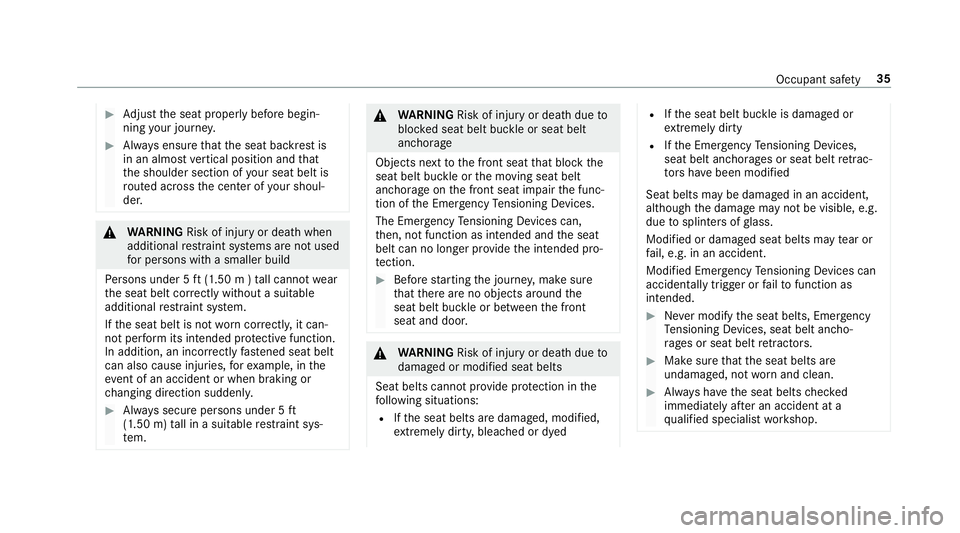
#Adjust the seat proper lybefore begin‐
ning your journe y.
#Always ensure that the seat backrest is
in an almost vertical position and that
th e shoulder section of your seat belt is
ro uted across the center of your shoul‐
der.
& WARNING Risk of injury or death when
additional restra int sy stems are not used
fo r persons with a smaller build
Pe rsons under 5 ft(1.50 m ) tall cannot wear
th e seat belt cor rectly wi thout a suitable
additional restra int sy stem.
If th e seat belt is not worncor rectly, it can‐
not per form its intended pr otective function.
In addition, an incor rectly fastened seat belt
can also cause injuries, forex ample, in the
ev ent of an accident or when braking or
ch anging direction suddenly .
#Always secure persons under 5 ft
(1.50 m) tall in a suitable restra int sys‐
te m.
&
WARNING Risk of injury or death dueto
bloc ked seat belt buckle or seat belt
anchorage
Objects next tothe front seat that block the
seat belt buckle or the moving seat belt
anchorage on the front seat impair the func‐
tion of the Emer gency Tensioning Devices.
The Emergency Tensioning Devices can,
th en, not function as intended and the seat
belt can no longer pr ovide the intended pro‐
te ction.
#Before starting the journe y,make sure
th at there are no objects around the
seat belt buckle or between the front
seat and door.
& WARNING Risk of injury or death dueto
damaged or modified seat belts
Seat belts cann otprov ide pr otection in the
fo llowing situations:
RIf th e seat belts are damaged, modified,
ex treme lydirty, bleached or dyed
RIfth e seat belt buckle is damaged or
ex treme lydirty
RIfth e Emer gency Tensioning Devices,
seat belt anchorages or seat belt retrac‐
to rs have been modified
Seat belts may be damaged in an accident,
although the damage may not be visible, e.g.
due tosplinters of glass.
Modified or damaged seat belts may tear or
fa il, e.g. in an accident.
Modified Emer gency Tensioning Devices can
accidental lytrig ger or failto function as
intended.
#Ne ver modify the seat belts, Emer gency
Te nsioning Devices, seat belt ancho‐
ra ge s or seat belt retractors.
#Make surethat the seat belts are
undamaged, not wornand clean.
#Alw ays ha vethe seat belts checked
immediately af ter an accident at a
qu alified specialist workshop.
Occupant saf ety 35
Page 48 of 562
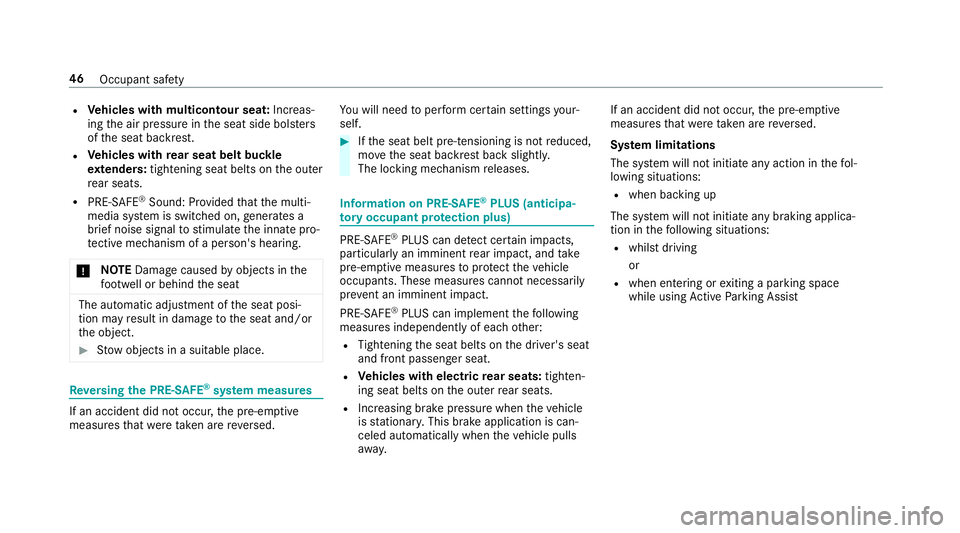
RVehicles with multicontour seat: Increas‐
ing the air pressure in the seat side bols ters
of the seat backrest.
RVe hicles with rear seat belt buckle
ex tenders: tightening seat belts on the outer
re ar seats.
RPRE- SAFE®Sound: Pr ovided that the multi‐
media sy stem is switched on, generates a
brief noise signal tostimulate the innate pro‐
te ctive mechanism of a person's heari ng.
* NO
TEDama gecaused byobjects in the
fo ot we ll or behind the seat
The automatic adjustment of the seat posi‐
tion may result in damage tothe seat and/or
th e object.
#St ow objects in a suitable place.
Reversing the PRE- SAFE®system measures
If an accident did not occur, the pre-em ptive
measures that we retak en are reve rsed. Yo
uwill need toper form certain settings your‐
self.
#If th e seat belt pre-tensioning is not reduced,
mo vethe seat backrest back slightl y.
The locking mechanism releases.
Information on PRE- SAFE®PLUS (anticipa‐
to ry occupant pr otection plus)
PRE- SAFE®PLUS can de tect cer tain impacts,
particular lyan imminent rear impact, and take
pre-em ptive measures toprotect theve hicle
occupants. These measures cannot necessarily
pr eve nt an imminent impact.
PRE-SAFE
®PLUS can implement thefo llowing
measures independently of each other:
RTightening the seat belts on the driver's seat
and front passenger seat.
RVe hicles with electric rear seats: tighten‐
ing seat belts on the outer rear seats.
RIncreasing brake pressure when theve hicle
is stationar y.This brake application is can‐
celed automatically when theve hicle pulls
aw ay. If an accident did not occur,
the pre-em ptive
measures that we retake n are reve rsed.
Sy stem limitations
The sy stem will not initiate any action in thefo l‐
lowing situations:
Rwhen backing up
The sy stem will not initiate any braking applica‐
tion in thefo llowing situations:
Rwhilst driving
or
Rwhen entering or exiting a parking space
while using Active Parking Assist
46
Occupant saf ety
Page 49 of 562
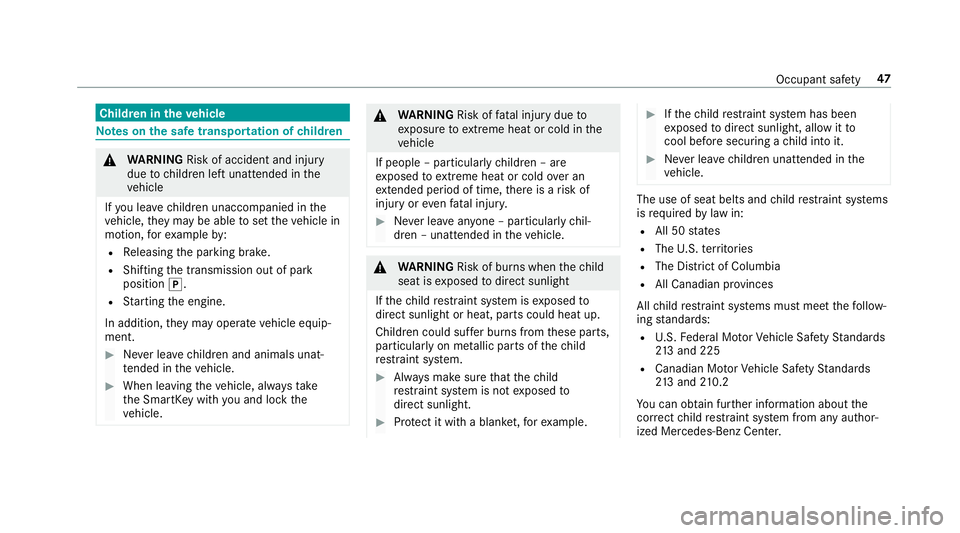
Children in theve hicle
Note s onthe safe transportation of children
&
WARNING Risk of accident and injury
due tochildren left unatte nded inthe
ve hicle
If yo u lea vechildren unaccompanied in the
ve hicle, they may be able toset theve hicle in
motion, forex ample by:
RRe leasing the parking brake.
RShifting the transmission out of park
position j.
RStarting the engine.
In addition, they may operate vehicle equip‐
ment.
#Ne ver lea vechildren and animals unat‐
te nded in theve hicle.
#When leaving theve hicle, alw aysta ke
th e SmartK eywith you and lock the
ve hicle.
&
WARNING Risk offata l injury due to
ex posure toextreme heat or cold in the
ve hicle
If people – particularly children – are
ex posed toextreme heat or cold over an
ex tended pe riod of time, there is a risk of
injury or evenfa ta l injur y.
#Never lea veanyone – pa rticularly chil‐
dren – unatte nded intheve hicle.
&
WARNING Risk of burn s whenthech ild
seat is exposed todirect sunlight
If th ech ild restra int sy stem is exposed to
direct sunlight or heat, parts could heat up.
Children could suf fer burns from these parts,
particularly on me tallic parts of thech ild
re stra int sy stem.
#Alw ays make sure that thech ild
re stra int sy stem is not exposed to
direct sunlight.
#Pr otect it with a blank et,fo rex ample.
#Ifth ech ild restra int sy stem has been
ex posed todirect sunlight, allow it to
cool before securi ng achild into it.
#Ne ver lea vechildren unatte nded inthe
ve hicle.
The use of seat belts and child restra int sy stems
is requ ired bylaw in:
RAll 50 states
RThe U.S. territories
RThe District of Columbia
RAll Canadian pr ovinces
All child restra int sy stems must meet thefo llow‐
ing standards:
RU. S. Federal Mo torVe hicle Saf etySt andards
21 3 and 225
RCanadian Mo torVe hicle Saf etySt andards
21 3 and 210.2
Yo u can obtain fur ther information about the
cor rect child restra int sy stem from any author‐
ized Mercedes-Benz Center.
Occupant saf ety 47
Page 57 of 562

Child safety loc ks
Activating/deactivating the child saf ety lock
fo r the rear doors
&
WARNING Risk of accident and injury
due tochildren left unatte nded inthe
ve hicle
If yo u lea vechildren unaccompanied in the
ve hicle, they may be able toset theve hicle in
motion, forex ample by:
RRe leasing the parking brake.
RShifting the transmission out of park
position j.
RStarting the engine.
In addition, they may operate vehicle equip‐
ment.
#Ne ver lea vechildren and animals unat‐
te nded in theve hicle.
#When leaving theve hicle, alw aysta ke
th e SmartK eywith you and lock the
ve hicle.
&
WARNING Risk offata l injury due to
ex posure toextreme heat or cold in the
ve hicle
If people – particularly children – are
ex posed toextreme heat or cold over an
ex tended pe riod of time, there is a risk of
injury or evenfa ta l injur y.
#Never lea veanyone – pa rticularly chil‐
dren – unatte nded intheve hicle.
&
WARNING Thereis arisk of accident
and injury if you lea vechildren unatte n‐
ded in theve hicle
If ch ildren are tra veling in theve hicle, they
could:
ROpen doo rs,th ereby endangering other
persons or road users.
RGet out of theve hicle and be hit by
oncoming traf fic.
ROpe rate ve hicle equipment and become
trapped, forex ample.
#Alw ays activate thech ild saf etyloc ks
av ailable if children are tra veling in the
ve hicle.
#Ne ver lea vechildren unatte nded inthe
ve hicle.
#When leaving theve hicle, alw aysta ke
th e SmartK eywith you and lock the
ve hicle.
Child saf etyloc ksare available forth ere ar doors
and forth ere ar side wind ows.
The child saf etyloc kon there ar doors secures
each door separatel y.The doors can no longer
be opened from the inside.
Occupant saf ety 55
Page 58 of 562
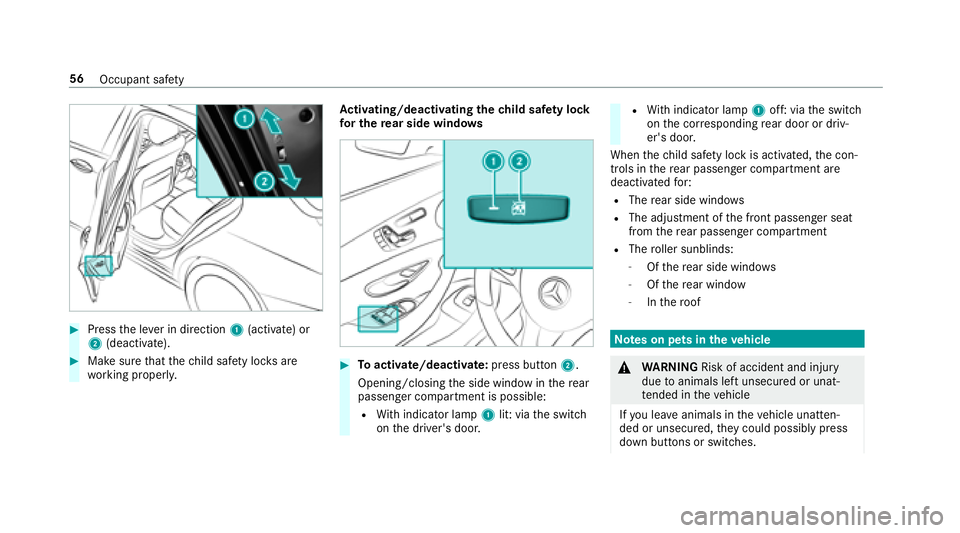
#Pressthe le ver in direction 1(activate) or
2 (deactivate).
#Make sure that thech ild saf etyloc ksare
wo rking properly. Ac
tivating/deactivating the child saf ety lock
fo r the rear side windo ws#Toactivate/deacti vate:press button 2.
Opening/closing the side window in there ar
passenger compartment is possible:
RWi th indicator lamp 1lit: via the switch
on the driver's door.
RWi th indicator lamp 1off: via the switch
on the cor responding rear door or driv‐
er's door.
When thech ild saf etyloc kis activated, the con‐
trols in there ar passenger compartment are
deactivated for:
RThe rear side wind ows
RThe adjustment of the front passenger seat
from there ar passenger compartment
RThe roller sunblinds:
-Of there ar side wind ows
-Ofthere ar wind ow
-Inthero of
Note s on pets in theve hicle
&
WARNING Risk of accident and injury
due toanimals left unsecured or unat‐
te nded in theve hicle
If yo u lea veanimals in theve hicle unatten‐
ded or unsecured, they could possibly press
down buttons or switches.
56 Occupant saf ety
Page 60 of 562

SmartKey
Overview of SmartK eyfunctions
&
WARNING Risk of accident and injury
due tochildren left unatte nded inthe
ve hicle
If ch ildren are left unatte nded intheve hicle,
th ey could:
ROpen doo rs,th ereby endangering other
persons or road users
RGet out of theve hicle and be hit by
oncoming traf fic
ROperate vehicle equipment
In addition, thech ildren could also set the
ve hicle in motion, forex ample, by:
RRe leasing the parking brake
RShifting the transmission out of park
position j
RStarting the engine.
#Ne ver lea vechildren and animals unat‐
te nded in theve hicle.
#When leaving theve hicle, alw aysta ke
th e SmartK eywith you and lock the
ve hicle.
#Ke ep the SmartK eyout of there ach of
ch ildren.
* NO
TEDama getotheke ycaused by
magnetic fields
#Ke ep theke yaw ay from strong mag‐
netic fields.
1Loc ks
2Battery check lamp
3Unloc ks
4Opens/closes the trunk lid
5Pa nic alarm
The Smart Keyloc ksand unlo cksth efo llowing
components:
RDoo rs
RTrunk lid
RFu elfiller flap
If yo u do not open theve hicle within appr ox‐
imately 40 seconds af ter unlocking:
RThe vehicle is loc ked again.
RAnti- theft pr otection is reactivated.
Do not keep the SmartK eytoget her with elec‐
tronic devices or me tal objects. This can af fect
th e SmartK ey's functionality.
Do not keep the SmartK eyinthete mp erature-
controlled cup holder. Otherwise, the SmartK ey
will not be reliably de tected.
% If battery check lamp 2does not light up
af te r pressing the% or& button, the
battery is dischar ged.
58
Opening and closing